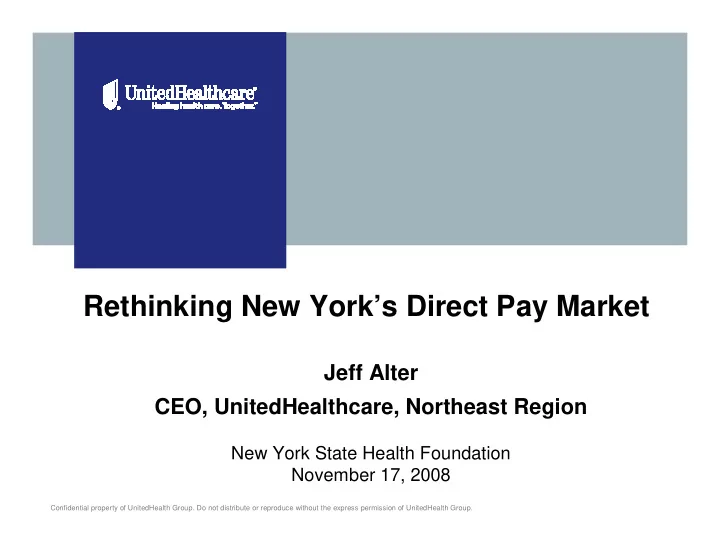

Rethinking New York’s Direct Pay Market Jeff Alter CEO, UnitedHealthcare, Northeast Region New York State Health Foundation November 17, 2008 Confidential property of UnitedHealth Group. Do not distribute or reproduce without the express permission of UnitedHealth Group.
Agenda 2 The goal of this presentation is to share some initial ideas for how to think differently about the Direct Pay market. This is a thought-starter – we look forward to collaborating with the State and other stakeholders. • Issues and Implications • Suggested Solution • Conclusion
Issues & Implications: Variability 3 There is huge variability in the Direct Pay market today in everything but benefits. - Monthly Premium - Variability in: $2,000 • Price $1,800 GHI $1,600 • Network $1,400 • Unit cost $1,200 Healthy NY $1,000 • Administrative expenses DP $800 $600 • Distribution system HIP $400 GHI HMO with drugs • Medical management policies $200 GHI EPO HDHP without drugs $0 • Quality care/health outcomes Low High Implications : Inefficiencies, unnecessary costs
Issues & Implications: Stop-Loss Inadequacy 4 The stop-loss pool created in 2000 to stabilize rates was frozen in 2004 and is no longer sufficient. • Covered claims through 2003 • Reduced to $37M in August 2008 • Now covers less than 50% of claims liability Implication Return of instability for both the consumer and carrier
Issues & Implications: Inflexible Benefit Design 5 The mandated benefit designs are extremely rich and haven’t kept up with the changing market. • Mandated benefit design requirements adopted by statute in 1995 – unchanged in 13 years • 1995-level office visit co-pays • Comprehensive drug & medical coverage • Low out-of-pocket cost sharing Implications • Generous benefit package + lack of flexibility = high premium cost • No incentive for healthy people to join • Lack of consumer choice of products • Outdated benefits given current health issues (e.g., wellness, chronic diseases)
Issues & Implications: Uneven Risk Selection 6 The people joining the Direct Pay market are those who need insurance (generally those with chronic conditions) and are willing to pay the higher price. • Mandated rich benefits encourages/allows high utilization • People who buy DP need insurance – generally those with chronic conditions • Current price points are unaffordable for the average uninsured person – likely to be exacerbated by current economic climate Implications • As membership continues to decline, premium cost will spiral out of control • High cost creates no incentive for healthy people to join = no ability to offset or balance risk
Issues & Implications: Summary 7 If we don’t take action now, the DP market risks collapse in the near future. Inflexible Uneven Stoploss + + Benefit Variability + Risk Inadequacy Design Selection • Premium increases • Enrollment declines = • Variability of health outcomes • Collapse of Direct Pay Market Rising Uninsured
Suggested Solution: Eliminate Variability 8 The first step is to create a stable platform for the future by getting into a single structure. This model leverages NYSHIP’s experience and unit costs. Existing Direct Pay NYSHIP Direct Pay Population – 12 carriers Community Pool Transfer current DP membership to NYSHIP vendors as condition of NYSHIP contract No initial benefit change � • One ID card for all DP market Efficiencies • One mechanism for claims payment • One network with one set of unit costs • One medical management process • Consistent pricing � Rating options • Initially - current community rating • Long-term - consider other rating strategies
Suggested Solution: Expand Pool/Benefit Choices 9 The second step is to attract better risk to offset those with chronic conditions. This will essentially create more of a true insurance product with a wider range of benefit options at a variety of price points. • Develop a new pool which will protect the current subscribers from benefit changes • Devise new, more flexible benefit options within this new pool to create choice and attract a wider variety of enrollees • Consider strategies to create a range in pricing: - Age/sex adjustments - Rating region adjustments - Wellness/DM adjustments • Market through State, consumer groups, clinicians and other stakeholders – e.g., Healthy NY campaigns
Suggested Solution: Better Manage Outcomes 10 The final step is to create a long-term solution that results in better care management, more appropriate utilization and ultimately lowers costs and creates higher quality of care and better outcomes. • Consumer engagement/ • Benefit Design Pilots wellness programs - Study population and identify - Healthy living (e.g., pregnancy) unique cost drivers - Wellness programs (e.g., - Develop benefit designs and weight management) care models targeted at these specific populations - Health assessments - Evaluate outcomes and - Educational outreach/mailings refine as necessary - Screening exam and • Chronic Care Coordination & immunization reminders Disease Management • Primary care/family physician - Predictive outreach pilots - Case management - Compliance support - Integrated pharmacy, medical, behavioral
Suggested Solution: Potential Premium Reduction 11 By implementing this solution, we should be able to reduce Direct Pay premiums by 17% without impacting tax payers or the small group pool. • Better economics 8% Medical • Lower insurance risk charge • More consistent medical management of chronic conditions + • Increased focus on wellness • PMPM-based charge within a cost 9% Medical structure already serving 1 million members = 17% TOTAL Savings Outcome •No increase in small group subsidy to Direct Pay market (Reg 146) – no additional burden to small group •Uses existing stoploss funding •No additional public monies required
Conclusion 12 The suggested solution addresses the current issues and returns the viability of Direct Pay as a long-term healthcare solution. Increase Better Eliminate Expand + + Benefit + Manage Variability Pool Designs Outcomes • Premium stability • Enrollment increase = • Better health outcomes • Viability of Direct Pay Market Slowdown in growth of uninsured
Recommend
More recommend